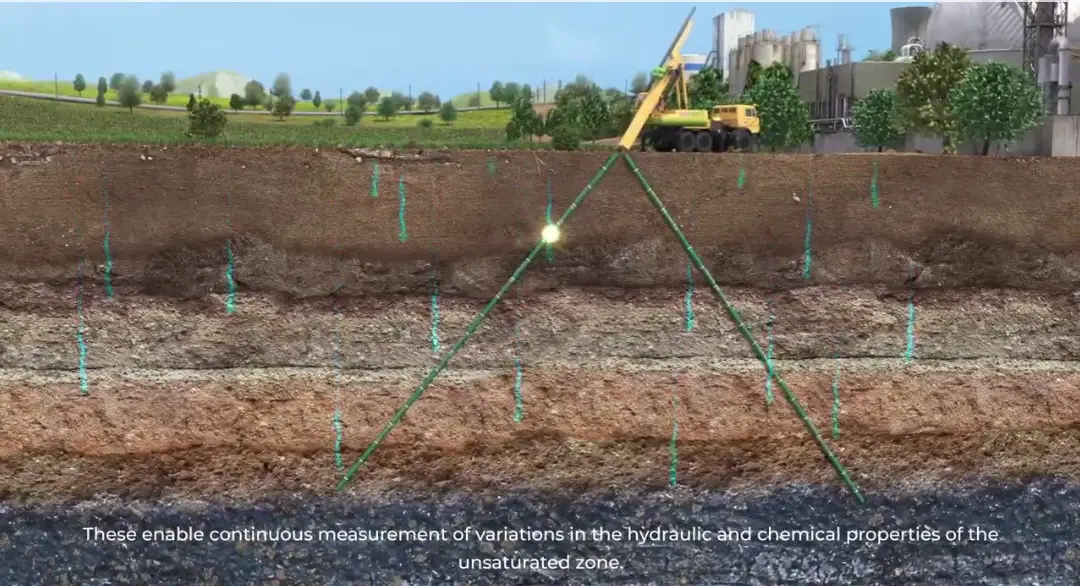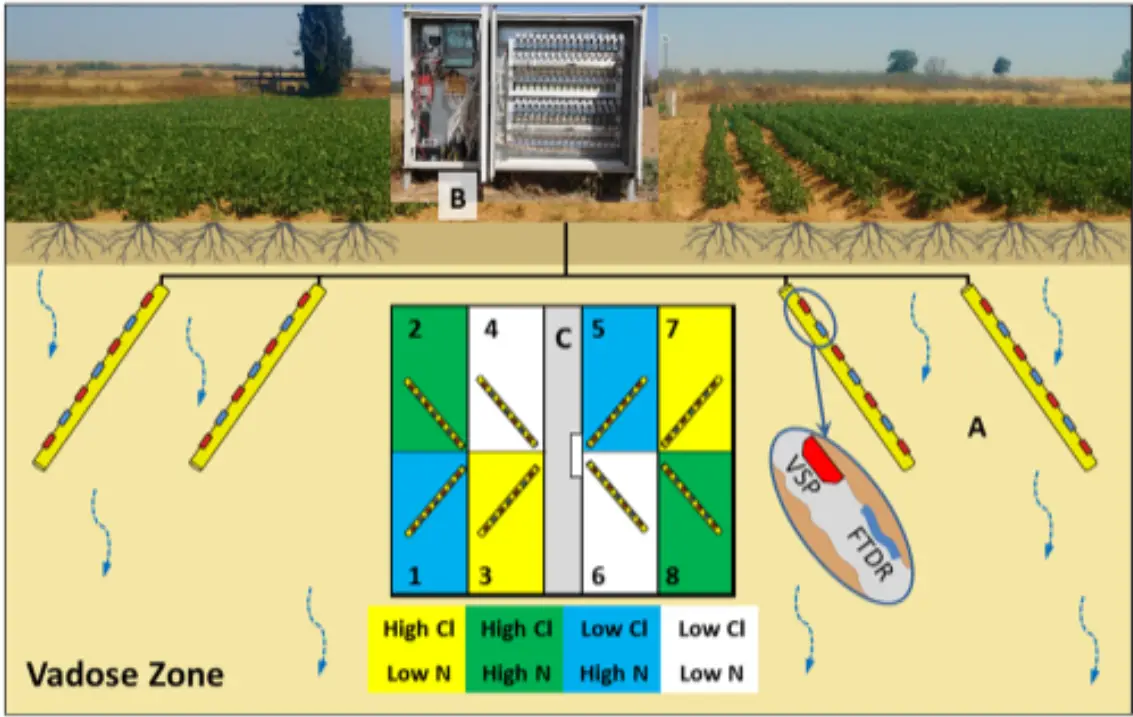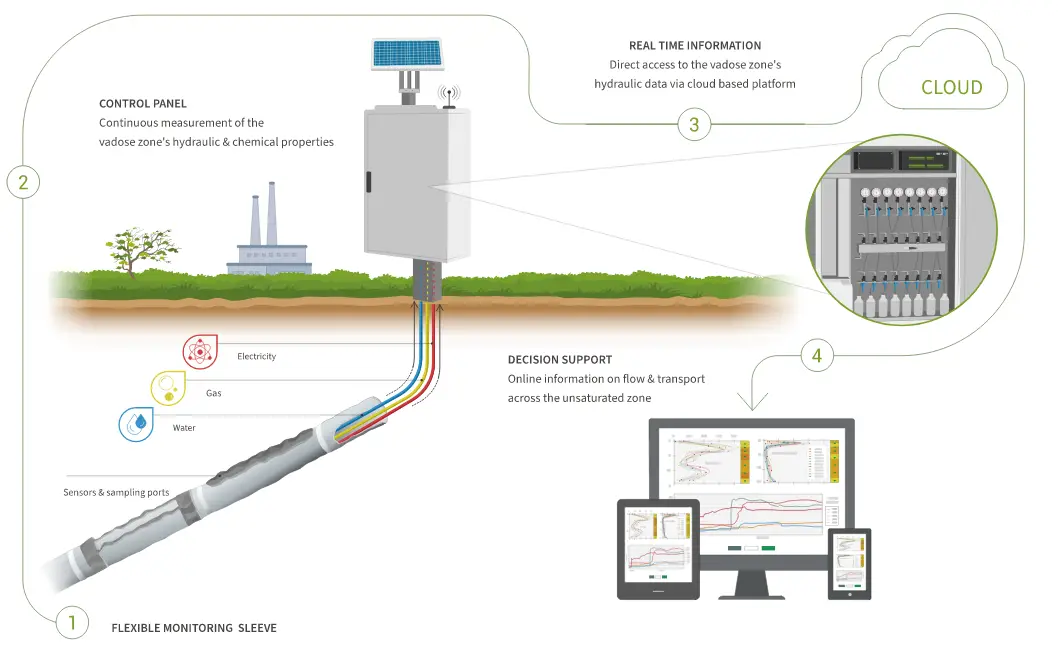Sistema de monitorização da zona de Vadose para a caracterização em tempo real da lixiviação de contaminantes para as águas subterrâneas em Israel
Vadose-zone
Voltar
Download the practice
People in charge of the innovative practice :
Não conhecido
This study implemented an innovative system, the Sensoil’s Vadose-zone Monitoring System™, which enables continuous monitoring and water sample collection directly from the vadose zone, providing real-time, continuous tracking of water percolation and contaminant transport across the vadose zone, from land surface to groundwater. Once installed, the VMS forms an accessible monitoring station (or network of stations) of the vadose zone.
Responsible entity
Sensoil Innovations Ltd. (Fig. 1) is a company developing and implementing smart soil sensing technologies and solutions, for the protection of groundwater and the environment.

The two main entities connected to this study are (Fig. 2) the Ben Gurion University of the Negev (Sde Boker Campus, Negev 84990, Israel) and The Volcani Center, Agricultural Research Organization (P.O. Box 6, Bet Dagan 50250, Israel).

Detailed explanation
The protection of groundwater resources from contamination is vital for the protection and sustainable use of this important water source.
In most situations, groundwater quality is assessed and sampled from wells and therefore the concentration of contaminants might already be at levels that will lead to disqualification of the aquifer as a source of drinking water, base flow for rivers or ecosystem support (cf. Fig. 4).

The knowledge of the time lag between initiation of a contamination process in the vadose zone and its final effect on aquifer quality are fundamental to provide decision-makers the opportunity to implement measures and more time to plan possible alternative plans for water supply.
The Sensoil vadose-zone monitoring system is a recently developed tool that enables continuous monitoring of the hydrological and chemical properties of percolating water in the deep vadose zone under agriculture settings (Turkeltaub et al., 2014, 2015) and other hydrological settings (e.g., Dahan et al., 2009; Baram et al., 2013) (Fig. 5).

The Vadose-zone Monitoring System (VMS) (Fig. 6) is composed of flexible sleeves (1) implemented in uncased, slanted boreholes. The flexible sleeves host multiple monitoring units, distributed along its length. Each monitoring unit is comprised of: water content sensors, vadose zone sampling ports and gas sampling ports for frequent sampling of the vadose zone. VMS data collection and water sampling is managed through Sensoil’s unique VMS control panel, installed on-site (2). Full access to real-time data, is available from anywhere, via the cloud (3). Data access is dedicated and customised to each customer (4).
The VMS sleeve is made of chemically resistant thin flexible liner, with integrally embedded monitoring units along its length. All monitoring units are connected to a control panel which is installed on the land surface. It is adapted for installation in 6″ diameter borehole drilled at 35º (to vertical), 55º (to horizon). Flexible Time Domain Reflectometry (FTDR) probes for monitoring of the sediment enable continuous measurement of water content and temperature of the sediment. Each and every FTDR sensor is tested for quality and performance and pre-calibrated for permittivity measurement in test medium of known dielectric properties.

The control panel is encased in a standard weather protected closet. A set of pressure manifolds valves and pressure gauges in the control panel allow direct access to each of the monitoring units for frequent sampling and regular maintenance.
A data-logger is used to collect data on water content, temperature and pressure measurements, providing real-time continuous data and advance warnings for decision support solutions. The software is able to receiving, storing, data-logging, processing, producing graphic charts, sending and accessing the raw and processed data. Access is dedicated and customised per customer. All data is protected by high-end security standards and under required privacy policy.
Fig. 7 shows an example of the results that can be obtained using Sensoil system. The objective of that study was to demonstrate the water flow and nitrate transport through the deep vadose zone underlying the crop field, with respect to rain patterns as well as the agricultural and fertilization setup.
It is possible to see the nitrate migration deeper into the vadose zone for different depths and the effect of rainy winters (e.g. 2012/13), with substantial nitrate breakthroughs noticeable throughout most of the vadose-zone cross section (marked with arrows in Fig. 7).

Institutional setting
Sensoil’s real-time monitoring technology is a crucial “early-warning” tool, recommended by government organizations and regulatory agencies.
Customers around the globe utilizing and relying upon Sensoil’s robust technology include: governments, regulatory agencies, municipalities, industrial and engineering companies, academia and research institutions.
Geographical setting
Israel (Fig. 3) is a country with low water availability, which has experienced almost seven consecutive years of drought between 2003/04 and 2010/11, and a five-year long drought between 2013 and 2018 (Gruère et al., 2020; OECD, 2020b).

However, nutrient surpluses have grown significantly: the nitrogen balance has increased between 2000 and 2018 from 189 to 236 kg/ha, reaching a level seven times above the OECD average, whereas the phosphorus balance has gone up from 66 kg/ha to 69 kg/ha during the same period (OECD, 2020a). VMS offers a system for real-time measurements of nutrient levels in the soil, providing farmers with relevant and timely data, enabling fertilization and irrigation optimization, to increase agricultural yield and quality, but also to protect groundwater.
Historical overview
This technology is the result of about 20 years of research lead by Professor Ofer Dahan, Ben Gurion University of the Negev, (Israel) and University of Nevada, Reno (USA).
Its application has started more recently (in 2016) and systems have been installed and applied in over 100 sites including in the EU, USA, China, Australia and Africa.
Evidence of benefits from implementation
Over 100 Vadose-zone Monitoring Systems have been installed around the globe over recent years. Aquifer and natural water source pollution occurrences have been avoided, remediation processes have been optimised, and scientific knowledge and research has improved. Also crop fertilization and irrigation schemes have been optimized.
Under References, a set of case-study sites and applications are listed, together with achieved benefits.
Replication potential in SUDOE region
The Sensoil vadose-zone monitoring system offers the possibility of real-time monitoring the vadose zone, having as main goal the protection of groundwater quality.
In agricultural areas, real-time measurements of nutrient levels and moisture sensors in the soil can provide farmers with relevant and timely data, enabling fertilization and irrigation optimization, to increase agricultural yield and quality and protect groundwater.
These systems can be installed in a range of applications in SUDOE region, where monitoring of the vadose zone, in addition to the saturated zone, is important, such as water resources protection, remediation, dam safety, landfill or mining. Some examples of achievements are:
- real time information on pollution processes taking place in the vadose zone, supporting decisions and measures to protect aquifers;
- assess transport and degradation pathways, and remediation treatment impacts, enabling optimization of in-situ remediation;
- provide continuous information on dam sediment moisture and real-time seepage, essential for improving dam embankment safety programs;
- provide real-time data on water flow velocities and chemical evolution of the percolating contaminants in and under a municipal landfill, allowing timely measures in landfill management.
Future outlook
Developing and implementing smart soil sensing technologies and solutions for the protection of groundwater, and the environment, is being done in over 100 sites including in the EU, USA, China, Australia and Africa.
These early warning systems are likely to expand due to their ability to bring real time information on pollution processes taking place in the unsaturated zone, long before contaminants accumulate in the aquifer.
Key points of the innovative method
In a nutshell, Sensoil system provides a unique integrated solution that incorporates (1) continuous monitoring and water sample collection of the vadose zone, (2) management control panel, installed on-site, (3) full access to real-time data, available from anywhere, via the cloud, and (4) data access dedicated and customised to each project needs.
Sensoil vadose-zone monitoring system allows the:
- Early detection of contamination sources in the vadose zone.
- Timely application of the necessary measures to avoid further contamination until reaching groundwater.
- Following remediation processes giving the necessary information for its continuous optimization.
Costs might be a drawback.
Acknowledgements
This innovative practice was suggested by Teresa E. Leitão from LNEC.
References
Aharoni, I., Siebner, H., and Dahan, O. (2017). Application of vadose-zone monitoring system for real-time characterization of leachate percolation in and under a municipal landfill. Waste Manag. doi:10.1016/j.wasman.2017.05.012.
Aharoni, I., Siebner, H., Yogev, U., & Dahan, O. (2020). Holistic approach for evaluation of landfill leachate pollution potential–From the waste to the aquifer. Science of The Total Environment, 741, 140367.
Avishai, L., Siebner, H., Dahan, O., and Ronen, Z. (2016). Using the natural biodegradation potential of shallow soils for in-situ remediation of deep vadose zone and groundwater. J. Hazard. Mater. 324, 398–405. doi:10.1016/j.jhazmat.2016.11.003.
Baram, S., Ronen, Z., Kurtzman, D., Külls, C., and Dahan, O. (2013). Desiccation-crack-induced salinization in deep clay sediment, Hydrol. Earth Syst. Sci., 17, 1533–1545, doi:10.5194/hess-17-1533-2013.
Dahan, O., Katz, I., Avishai, L., & Ronen, Z. (2017). Transport and degradation of perchlorate in deep vadose zone: implications from direct observations during bioremediation treatment. Hydrology & Earth System Sciences, 21(8).
Dahan, O., Talby, R., Yechieli, Y., Adar, E., Lazarovitch, N., and Enzel, Y. (2009). In situ monitoring of water percolation and solute transport using a vadose zone monitoring system, Vadose Zone J., 8, 916–925, doi:10.2136/vzj2008.0134.
Fernández de Vera, N., Beaujean, J., Jamin, P., Hakoun, V., Caterina, D., Dahan, O., Vanclooster, M., Dassargues, A., Nyugen, F. and Brouyère, S. (2017). Tracer experiment in a brownfield using geophysics and a vadose zone monitoring system. Vadose Zone Journal, 16(1), 1-15.
Gruère, G., M. Shigemitsu and S. Crawford (2020). Agriculture and water policy changes: Stocktaking and alignment with OECD and G20 recommendations, OECD Food, Agriculture and Fisheries Papers, No. 144, OECD Publishing, Paris, http://dx.doi.org/10.1787/f35e64af-e
Levakov, I., Han, J., Ronen, Z., & Dahan, O. (2020). Inhibition of perchlorate biodegradation by ferric and ferrous iron. Journal of Hazardous Materials, 124555.
Levakov, I., Ronen, Z., & Dahan, O. (2019). Combined in-situ bioremediation treatment for perchlorate pollution in the vadose zone and groundwater. Journal of hazardous materials, 369, 439-447.
Moshkovich, E., Ronen, Z., Gelman, F., & Dahan, O. (2018). In Situ Bioremediation of a Gasoline‐Contaminated Vadose Zone: Implications from Direct Observations. Vadose Zone Journal, 17(1), 1-11.
OECD (2020a). “Nutrient balance” (indicator), https://doi.org/10.1787/82add6a9-en
OECD (2020b). “Freshwater abstractions”, https://stats.oecd.org
OECD (2020c). Agricultural Policy Monitoring and Evaluation 2020, OECD Publishing, Paris, https://doi.org/10.1787/928181a8-en
Scanlon, B. R., Reedy, R. C., Gates, J. B., and Gowda, P. H. (2010). Impact of agroecosystems on groundwater resources in the Central High Plains, USA, Agr. Ecosys. Environ., 139, 700–713.
Spalding, R. F.,Watts, D. G., Schepers, J. S., Burbach, M. E., Exner, M. E., Poreda, R. J., and Martin, G. E. (2001). Controlling nitrate leaching in irrigated agriculture, J. Environ. Qual., 30, 1184–1194.
Turkeltaub, T., Dahan, O., and Kurtzman, D. (2014). Investigation of groundwater recharge under agricultural fields using transient deep vadose zone data, Vadose Zone J., 13, 1–13, doi:10.2136/vzj2013.10.0176.
Turkeltaub, T., Kurtzman, D., and Dahan, O. (2016). Real-time monitoring of nitrate transport in the deep vadose zone under a crop field – implications for groundwater protection, Hydrol. Earth Syst. Sci., 20, 3099–3108, https://doi.org/10.5194/hess-20-3099-2016,
Turkeltaub, T., Kurtzman, D., Russak, E. E., and Dahan, O. (2015). Impact of switching crop type on water and solute fluxes in deep vadose zone, Water Resour. Res., 51, 9828–9842, doi:10.1002/2015WR017612.
Weissman, G., Bel, G., Ben‐Gal, A., Yermiyahu, U., Alexandrov, B., Rasmussen, K. Ø., & Dahan, O. (2020). Increased irrigation water salinity enhances nitrate transport to deep unsaturated soil. Vadose Zone Journal, 19(1), e20041, https://doi.org/10.1002/vzj2.20041.
Yeshno, E. Arnon, S. Dahan, O. (2019). Continuous in-situ monitoring of nitrate concentration in soils – a key for groundwater protection from nitrate pollution. Hydrol Earth Syst Sci, https://doi.org/10.5194/hess-2019-198.
Internet references:
Sensoil’s Vadose-zone Monitoring System https://sensoils.com/technology/
Israel Export Institute https://www.export.gov.il/catalog/cleantechcatalogue/aboutcompany/9066/7284
Other sources:
https://www.linkedin.com/company/sensoil/?originalSubdomain=il
aquifer
NOTÍCIAS
Descubra mais sobre as notícias do projeto AQUIFER e sobre a gestão de aquíferos
NOTÍCIAS AQUIFER
Descrição e objectivos do projecto
The scientific community recommends a substantial improvement in the knowledge of aquifers, the establishment of reliable monitoring networks and a greater involvement of the administration and users to achieve a sustainable management of aquifers. The main objective...
Informação sobre o projecto
A Comunidade de Utilizadores de Água do Delta Llobregat concebeu bacias de recarga em Molins de Rei para recarregar o aquífero do Baix Llobregat. Vista de uma das bacias de recarga durante a fase de teste A Comunidade de Utilizadores de Água de Llobregat Delta é um...
Histórias de sucesso na gestão das águas subterrâneas
Compilação de histórias de sucesso na gestão das águas subterrâneas. Ao longo do mês de Abril, os 30 casos de práticas inovadoras na gestão das águas subterrâneas já foram seleccionados pelos agrupamentos que participam no projecto: PPA, CWP e AV. A tarefa começou com...
PROPONHA UMA
PRÁTICA INOVADORA
Está a desenvolver ou implementar uma prática inovadora em matéria de gestão de aquíferos e deseja referência-la na plataforma do projeto AQUIFER?
Preencha o formulário e faça uma proposta aos parceiros do projeto AQUIFER.
THE E-BOOK
O Aquífero oferece uma gama de práticas inovadoras de gestão da água. Pode descarregar todas as nossas fichas técnicas aqui.
E-BOOK DE PRÁTICAS INOVADORAS
DOCUMENTAÇÃO
Aprofunde a informação relacionada com a gestão dos aquíferos